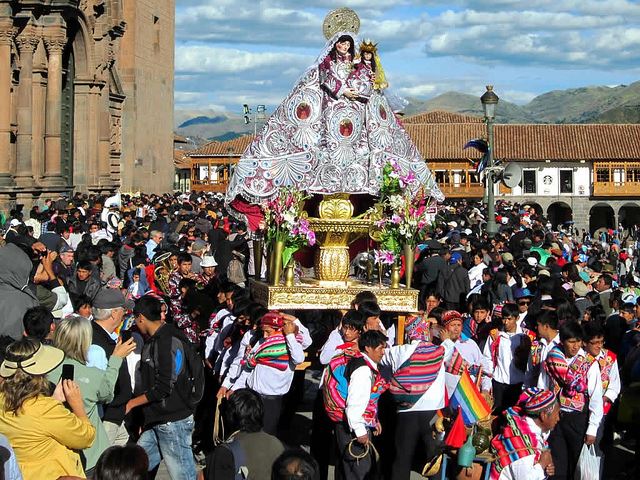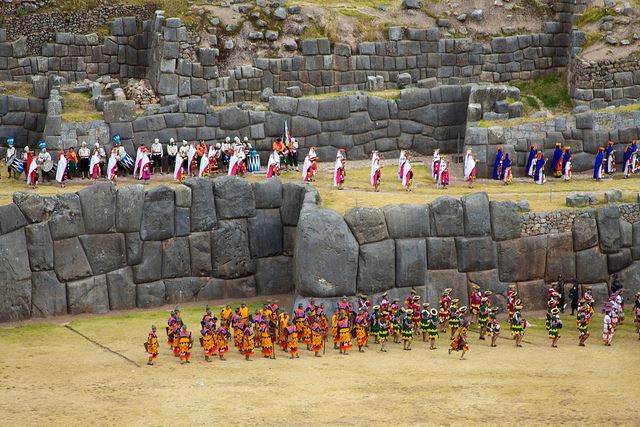
3 Cusco festivals you have to go to
People across Peru celebrate thousands of festivals each year, but in the Andes three of the biggest take place in May and June. Bright colors, lengthy processions, and a mixture of Catholicism and folklore characterize them all, but each has a personality of its own. Find out which celebration in Cusco best fits your travel style, and consider incorporating a day of Peruvian festivities into your visit to Machu Picchu and the Inca capital.
Authentic Pilgrimage: Qoyllur Rit’i

What: Qoyllur Rit’i
Why: Qoyllur Rit’I is a 3-day Andean pilgrimage combining indigenous and Catholic beliefs. Tens of thousands of rural families walk for days to participate and to pay respect both to the Apus (mountain gods) and to Jesus Christ.
Long before the Spanish introduced Catholicism to Peru, Andean people braved thin and frigid mountain air 15,000 feet above sea level to pay their respect to the Lord of the Snow Star. Glacier ice was, and still is, considered sacred. The celebration shifted in 1780 when an apparition of Jesus appeared to a shepherd boy, and left behind a holy imprint on a rock.
Today the massive pilgrimage combines nature worship and Catholic veneration without contradiction. Tarp tents act as temporary housing, food stalls, and markets to create a sky-high spiritual camp scattered across the mountainside. Thousands line up to pray and place candles inside a simple church and leave offerings at crosses. Villagers come in traditional dress and gather together to dance. Costumed Ukukos, adorned as man-bears with masks, act as semigods and pagan priests, taking the lead role in many of the rituals. A mystic market with symbolic icons of houses, cars, health, and children allow believers to purchase their every dream. With each village divided into its own nation group, Qoyllur Rit’I is a chaotic and free-flowing celebration.
When: End of May or beginning of June; on the full moon before Corpus Christi. This year, Qoyllur Rit’I is held on May 25-29, 2013.
Where: The main ceremony takes place in the province of Ocongate at the base of Mount Ausangate. Many gather in the Sinakara Valley, eight hours from Cusco, and then walk up the mountain to the edge of the glacier.
Who should participate? Qoyllur Rit’I takes place at an extremely high altitude. Visitors must hike for several hours and spend the night in basic tent lodging. Only travelers with good physical fitness who are already adjusted to altitude should consider attending. Qoyllur Rit’I is not a tourist attraction, but a sacred ritual and celebration for the rural populations of southern Peru.
Catholicism in Cusco: Corpus Christi

What: Corpus Christi
Why: Corpus Christi is a Romanc Catholic event celebrated around the world. In Peru, one of the most lavish Corpus Christi Celebrations takes place in Cusco. The event commemorates the practice of Holy Communion and the sacred body of Christ within the bread and wine of the Eucharist.
In Cuzsco, Corpus Christi consists of a massive procession of saints and virgins from the city’s numerous churches, as well as those from surrounding villages. Because the procession is done on foot, and many of the religious figures are heavy and difficult to carry, those coming from rural communities may start their procession days in advance. On May 30th the central plaza and the surrounding streets are closed for the main celebration. The figures and saints are returned back to their respective churches eight days later.
When: End of May. This year Corpus Christi in Peru is held on May 29-30, 2013.
Where: Cusco, Plaza de Armas
Who should participate? Corpus Christi takes place in public streets and plazas. Anyone can watch the procession.
Ancient Reenactment: Inti Raymi

What: Inti Raymi
Why: Inti Raymi is an ancient Inca celebration worshiping Inti, the sun god. Though the Incas honored other natural elements, particularly Pachamama (Mother Earth) it was Inti who gave the leaders of the Inca Empire their divine right to rule, along with the warmth and light required for a successful crop.
During Incan times, Inti Raymi was a week-long religious celebration incorporating dancing, singing, llama sacrifice, and ceremonial sowing with a golden plow. The practice was outlawed in 1572 by the Viceroy of Peru. Hundreds of years later, Peruvian scholars brought Inti Raymi back to life. They studied colonial records and created a Quechua script and put on the first modern-day Inti Raymi celebration in 1944. It has since morphed into an extremely elaborated event with hundreds of costumed participants and thousands of spectators.
When: Annually on June 24.
Where: Cusco. Procession goes from Qorikancha to the Plaza de Armas. The reenactment takes place at Sacsayhuaman.
Who should participate? Anyone can enjoy the Inti Raymi procession in Cusco. If you want to see the entire reenactment, you’ll have to purchase an entrance ticket for Sacsayhuaman. Though Inti Raymi stems from actual Inca culture, visitors should expect a fun performance, not an authentic Andean tradition. Cusco is very crowded during Inti Raymi.
Have we convinced you yet? Speak to a Destination Expert about curating a tailor made Peru itinerary just for you, or check out our most popular Machu Picchu & Peru tours here.
Thanks to Comicpie for the title image of this blog.